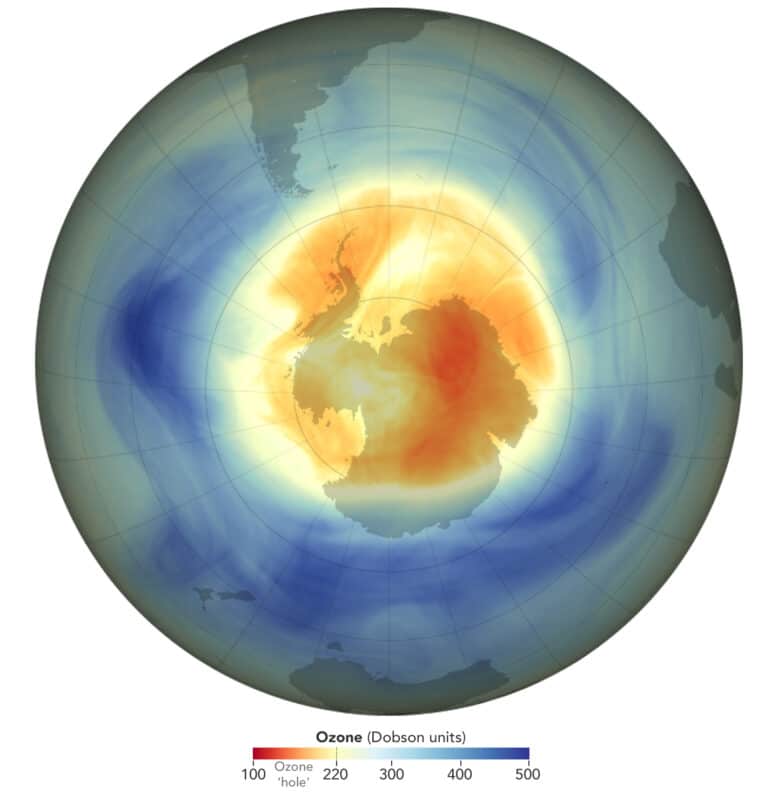The ozone hole over Antarctica in 2025 is showing signs of positive change, ranking as the fifth smallest hole since 1992, when international agreements like the Montreal Protocol began curbing ozone-depleting chemicals. According to scientists from NOAA and NASA, this shift reflects the ongoing success of global efforts to protect the ozone layer. With further recovery anticipated in the coming decades, the results are promising, showing a consistent trend toward healing. NOAA highlights this as a significant achievement for the environment.
The Ozone Hole’s Shrinking Trend: A Clear Sign of Recovery
The ozone hole over Antarctica, historically a concerning environmental issue, has continued to shrink in size over recent years, with the 2025 hole being one of the smallest since 1992. Scientists, including Paul Newman from NASA, have noted, “As predicted, we’re seeing ozone holes trending smaller in area than they were in the early 2000s. They’re forming later in the season and breaking up earlier.” This is a key observation showing that the hole is no longer as persistent or widespread as it once was.
The Montreal Protocol, a landmark international agreement, was instrumental in phasing out the use of harmful chemicals like CFCs, which have long been responsible for ozone depletion. With stricter regulations in place, the concentration of ozone-depleting substances has fallen dramatically. This decline is expected to continue, leading to the eventual recovery of the ozone layer over the coming decades. As the NOAA report underscores, the positive trajectory is evident, showing that the global push for cleaner alternatives to harmful chemicals is succeeding.

How the Montreal Protocol Made a Difference
The Montreal Protocol, enacted in 1987, marked a turning point in the fight against ozone depletion. By phasing out substances like CFCs and halons, which were primarily used in refrigeration and aerosol products, the protocol laid the groundwork for significant atmospheric changes. Today, levels of these ozone-depleting chemicals in the Antarctic stratosphere have dropped by approximately a third since their peak around the year 2000, according to Stephen Montzka, senior scientist at NOAA’s Global Monitoring Laboratory. This reduction has been crucial in the ongoing recovery of the ozone layer.
Before these regulations, the ozone layer over Antarctica thinned dramatically, allowing more harmful ultraviolet (UV) radiation to reach Earth’s surface. This has been linked to an increase in skin cancer, cataracts, and other health issues, along with adverse impacts on ecosystems. With the reduction of ozone-depleting substances, the world is on track to see a full recovery by the late 2060s.
A Smaller Ozone Hole in 2025: What It Means for the Planet
This year’s ozone hole reached its maximum extent on September 9, 2025, covering about 8.83 million square miles—roughly 30% smaller than the largest hole ever recorded in 2006. As NASA’s Newman points out,
“This year’s hole would have been more than one million square miles larger if there was still as much chlorine in the stratosphere as there was 25 years ago.”
This reduction illustrates the profound effect the Montreal Protocol and its amendments have had in reversing the damage done by industrial chemicals.
The smaller ozone hole also indicates a more favorable atmospheric trend, which has been observed over the past decade. The hole is not only shrinking in size but is also breaking up earlier in the season. This could signal a reduction in the harmful effects of ultraviolet radiation that had once been a major concern for both human health and ecosystems.
The Role of Atmospheric Conditions in Ozone Hole Formation
While the decline in ozone-depleting chemicals has been the primary factor in the smaller ozone hole, atmospheric conditions also play a crucial role in its formation and size. This year, a weaker-than-normal polar vortex contributed to a smaller hole. The polar vortex is a large mass of cold air that circulates around the Antarctic, and when it weakens, temperatures rise slightly, which can reduce ozone depletion.
As Laura Ciasto, a meteorologist with NOAA, explains, “A weaker-than-normal polar vortex this past August helped keep temperatures above average and likely contributed to a smaller ozone hole.” This illustrates the complex interplay of natural and human-driven factors in shaping the state of the ozone layer each year.
What’s Next for the Ozone Layer? The Road to Full Recovery
The recovery of the ozone layer is far from complete, but the progress made in recent decades is encouraging. As the levels of ozone-depleting chemicals continue to drop, the ozone hole is expected to shrink further and eventually close up entirely by the late 2060s. This is a hopeful outlook for both the environment and human health, as the ozone layer acts as Earth’s protective shield against harmful ultraviolet radiation.
Scientists continue to monitor ozone levels using advanced satellite technology and weather balloons, gathering essential data that helps track changes in the ozone hole’s size and intensity. Ongoing research is vital to ensuring that recovery continues as expected.

